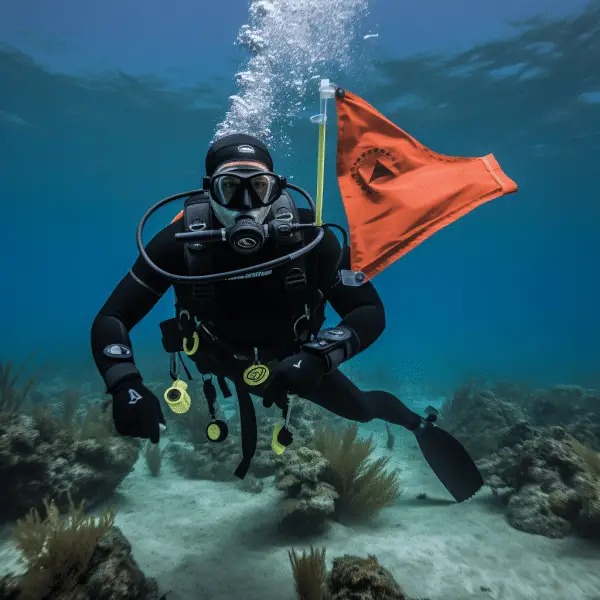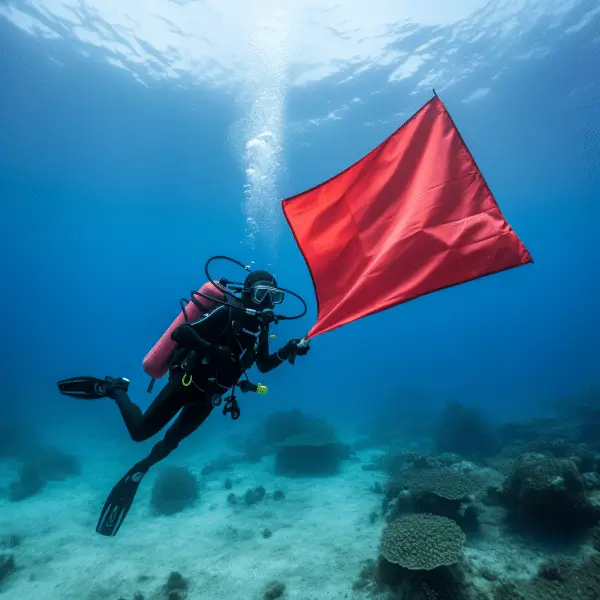Dive flags and floats are essential safety equipment for scuba divers. They play a crucial role in ensuring the safety of divers underwater and alerting boat traffic to their presence. By understanding the importance of dive flags and floats, divers can enhance their safety and prevent accidents in the water.
When scuba diving, it is important to have the right safety equipment, and dive flags and floats are an integral part of that. Dive flags are used to signal the presence of divers below and warn boaters to keep a safe distance. They are particularly important in inland waterways and offshore sites, where boat traffic can pose a significant risk to divers. By displaying the appropriate dive flag and adhering to diving regulations, divers can promote safe scuba diving practices and prevent collisions with boats.

Key Takeaways:
- Dive flags and floats are essential safety equipment for scuba divers.
- They serve as visual indicators to alert boaters of the presence of divers.
- Understanding the different types of dive flags and their functions is crucial for effective communication.
- Choosing and using dive flags and floats in accordance with local diving regulations is important.
- Divers should always stay within the designated distance from their dive flag and be aware of their surroundings.
Types of Dive Flags and Their Functions
When it comes to scuba diving, dive flags are essential safety tools that communicate the presence of divers and promote safe practices in the water. There are two main types of dive flags commonly used in scuba diving:
Diver Flag:
The diver flag and the alpha flag are the two most common kinds of diving flags. Rectangular in shape, the diver flag is red and has a white diagonal stripe to denote the presence of a diver. Dive boats flying the blue and white pennant flag known as the alpha flag, or international code flag “A,” alert mariners to the presence of divers on board and signal that the vessel is too small for quick maneuvering.
Alpha Flag:
Diving vessels fly the alpha flag, commonly known as the international code flag “A,” to indicate they are diving and have limited maneuverability. The alpha flag alerts other vessels to give the dive boat priority. This flag minimizes boat collisions and protects divers in busy areas. Boat divers must understand the alpha flag.
Both types of dive flags alert other boaters to scuba diving safety and prevent mishaps. Divers must know how these flags work and follow local rules. Utilizing dive flags properly can make diving safer and more enjoyable.
In the table below, we summarize the types of dive flags and their functions:
| Type of Dive Flag | Function |
|---|---|
| Diver Flag | Indicates the presence of submerged divers and warns boaters to exercise caution. |
| Alpha Flag | Signals that a diving vessel is engaged in diving activities and has limited maneuverability, requiring other boaters to yield right of way. |
Choosing and Using Dive Flags and Floats
Dive flags require numerous factors. First, choose a staff/pole or float flag. Staff flags are flown aboard diving boats, while float flags float on the water. Put a staff flag in a prominent spot on the boat and high enough to see above the waves. Float flags include inflatable buoys, torpedo-shaped floats, and heavy-duty surface support rings. Personal preference and diving conditions determine the choice.
Diving flag laws vary by location, therefore it’s important to know them. Some restrictions limit the type, size, and distance of flags from the diver. Following these rules ensures safety and prevents fines and accidents. Make sure your dive flag satisfies the requirements and is constructed of marine-friendly materials.
Individual flags can be personalized to represent divers’ style and personality. These flags can be connected to the diver’s BCD or tank for underwater identification. Personal flags personalize your diving gear and let other divers and boat operators recognize you. Make sure your own flag doesn’t block diving equipment or compromise your safety.
Table: Dive Flag Types and Specifications
| Flag Type | Color | Design | Size |
|---|---|---|---|
| Diver Flag | Red with white diagonal stripe | Rectangular | Minimum 20 x 24 inches |
| Alpha Flag | Blue and white pennant | Pennant-shaped | Minimum 12 x 15 inches |
Remember, dive flags are essential tools for promoting diver safety and preventing accidents in the water. By choosing the right type of flag and displaying it correctly, you can communicate your presence to other boaters and ensure a safe diving experience for yourself and others. Always follow diving regulations, stay within the designated distance from your dive flag, and maintain situational awareness to avoid potential hazards. Safe diving starts with responsible flag selection and usage

Conclusion
Dive flags and floats are essential safety equipment for scuba divers. They serve as visual indicators to alert other boaters of the presence of divers and the need to exercise caution and maintain a safe distance.
Understanding the different types of dive flags and their functions is important for ensuring effective communication and adherence to diving regulations. The primary purpose of dive flags is to prevent accidents and potential injuries from boat propellers. By choosing and using dive flags properly, divers can enhance their safety and prevent accidents in the water.
To ensure safe and pleasurable scuba diving, follow local diving regulations, stay within the dive flag’s distance, and be alert of your surroundings. Use dive flags and floats properly and learn the local norms to ensure safety.
FAQ
Do I need to fly a dive flag when scuba diving?
To guarantee the safety of scuba divers, dive flags are necessary in most inland waterways and offshore areas. Warning boat traffic of divers below is crucial so that they can stay a safe distance.
What are the types of dive flags used in scuba diving?
The diver flag and the alpha flag are the two most common kinds of diving flags. Rectangular in shape, the diver flag is red and has a white diagonal stripe to denote the presence of a diver. Dive boats flying the blue and white pennant flag known as the alpha flag, or international code flag “A,” alert mariners to the presence of divers on board and signal that the vessel is too small for quick maneuvering.
How do I choose and use dive flags and floats?
When choosing dive flags, you can opt for a staff/pole flag flown on the dive boat or a float flag designed to float on the water’s surface. Ensure that the staff flag is high enough to be visible above waves and placed prominently on the boat. Float flags can range from inflatable buoys to torpedo-shaped floats or surface support rings. Familiarize yourself with local diving regulations regarding the use of dive flags as they may vary in different locations. Always stay within the designated distance from your dive flag and be aware of your surroundings to avoid accidents.
Why are dive flags important for scuba diving safety?
Dive flags are crucial for promoting safe scuba diving practices and preventing collisions with boats. By alerting other vessels to dives below, dive flags assist keep divers safe from propeller mishaps. Divers and boaters must follow dive flag display and speed limits to stay safe.
What should I do if I encounter a dive flag while boating?
When you encounter a dive flag while boating, it is important to reduce your speed, exercise caution, and maintain a safe distance from the flag and the area around it. Divers may be submerged below, and boaters should always give them the right of way. By respecting dive flags and being mindful of divers’ presence, you contribute to the safety of everyone in the water.
Can I use a personal dive flag?
Some divers choose to use personal dive flags in addition to the standard flags. Personal dive flags can help divers identify their specific location in the water and make them more visible to other boaters. However, it is essential to ensure that personal dive flags do not conflict with or replace the required diver flag or alpha flag. Always check local regulations to ensure that personal dive flags are permissible and do not pose any safety concerns.
